
Baron Dunboyne was a title first held by the Petit family some time after the Norman invasion of Ireland.
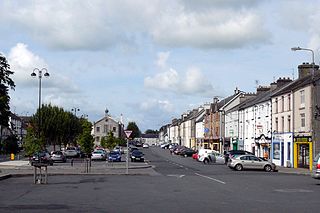
Templemore is a town in County Tipperary, Ireland. It is a civil parish in the historical barony of Eliogarty. It is part of the parish of Templemore, Clonmore and Killea in the Roman Catholic Archdiocese of Cashel and Emly.
Sir Walter Butler, 11th Earl of Ormond and 4th Earl of Ossory (1559–1633), succeeded his uncle Black Tom, the 10th earl, in 1614. He was called "Walter of the Beads" because he was a devout Catholic, whereas his uncle had been a Protestant. King James I intervened and awarded most of the inheritance to his uncle's Protestant daughter Elizabeth. Ormond contested the King's decision and was for that insolence detained in the Fleet Prison from 1619 until 1625 when he submitted to the King's ruling. He then found a means to reunite the Ormond estate, by marrying his grandson James, who had been raised a Protestant, to Elizabeth's only daughter.

Bansha is a village in County Tipperary in Ireland. The village is part of the parish of "Bansha and Kilmoyler" in the Roman Catholic Archdiocese of Cashel and Emly. It is in the historical barony of Clanwilliam. Bansha is co-extensive with the pre-Reformation parish of Templeneiry of which the townland name of Templenahurney is thought to be a corruption. While the village is the focal point of the area, there is also an outlying hamlet in the parish, located at Rossadrehid where a rural creamery once serviced the dairy industry.
Richard Butler, 1st Viscount Mountgarret was the son of Piers Butler, 8th Earl of Ormond and Lady Margaret Fitzgerald. He married his half first cousin Eleanor Butler, daughter of Theobald Butler of Polestown, the illegitimate brother of the 8th Earl of Ormond. He was created 1st Viscount Mountgarret in 1550.
John Butler, 12th Baron Dunboyne was an Irish clergyman and aristocrat, Roman Catholic Bishop of Cork and Ross. In order to advance his temporal title and marry he became, as of 2004, the only authenticated apostate in the Catholic hierarchy in Ireland

Theobald Walter was the first Chief Butler of Ireland. He also held the office of Chief Butler of England and was the High Sheriff of Lancashire for 1194. Theobald was the first to use the surname Butler of the Butler family of Ireland. He was involved in the Irish campaigns of King Henry II of England and John of England. His eldest brother Hubert Walter became the Archbishop of Canterbury and justiciar and Lord Chancellor of England.

O'Dwyer, also known as Dwyer,Dyer is one of Ireland's oldest Gaelic noble or aristocratic houses, based most prominently in what is today County Tipperary. The name means "dark coloured", in reference to their progenitor Dubhuir mac Spealáin's hair colour.

The O'Kennedy family, sometimes Kennedy, were an Irish royal dynasty, a sept of the Dál gCais, founded in the Middle Ages who were Kings of Ormond. Their founder was the nephew of High King Brian Boru (1002–1014). The name Cinnéide belonged to Brian Boru's father Cennétig mac Lorcáin, King of Thomond, in the tenth century AD.. The Kennedys did not descend directly from Brian Boru, but from Cinnéide's eldest son Donncuan. Donncuan's son Mahon was the first to call himself Ó Cinnéide which is Irish for grandson of Cinnéide.

Sir Edmund Butler of Cloughgrenan, was an Irish noble and the second son of James Butler, 9th Earl of Ormond and Lady Joan Fitzgerald. He was a scion of the House of Ormond, and a rebel against the Tudors.
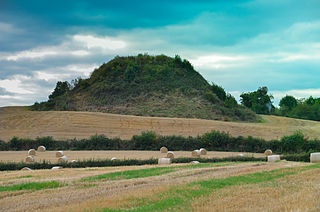
Knockgraffon is a townland in the civil parish of the same name in County Tipperary, Ireland. The civil parish lies in the barony of Middle Third. The townland is around 5 km north of Cahir. It is also part of the ecclesiastical parish of New Inn & Knockgraffon in the Roman Catholic Archdiocese of Cashel and Emly. Interesting features include a fine motte, a church and a castle.

Earl of Glengall was a title in the Peerage of Ireland that was created in 1816 for Richard Butler, 10th Baron Cahir. The subsidiary title of Baron Cahir in the Peerage of Ireland was first created in 1542 for Thomas Butler, who was a descendant of The 3rd Earl of Ormond. James "Gallda" Butler was the son of the 3rd Earl and Catherine FitzGerald of Desmond. "Gallda" Butler married a daughter of MacWalter and together they had one son, Piers (1425-1464). The title was re-created in 1583 with the unusual remainder to heirs general of the first baron, which made his great-nephews, Theobald Butler and Thomas Prendergast, co-heirs. Prendergast ceded the title to Theobald Butler, preferring that the title should follow the strict male line.
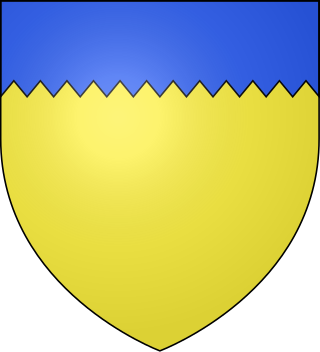
Butler is the name of a noble family whose members were, for several centuries, prominent in the administration of the Lordship of Ireland and the Kingdom of Ireland. They rose to their highest prominence as Dukes of Ormonde. The family has produced multiple titles such as Baron Cahir, Baron Dunboyne, Viscount Ikerrin, Viscount Galmoye, Viscount Mountgarret, Viscount Thurles, Earl of Carrick, Earl of Kilkenny, Earl of Ormond, Earl of Ossory, Marquess of Ormonde and Duke of Ormonde. Variant spellings of the name include le Boteler and le Botiller. The Butlers were descendants of Anglo-Norman lords who participated in the Norman invasion of Ireland in the 12th century. The surname has its origins in the hereditary office of "Butler (cup-bearer) of Ireland", originating with Theobald Walter, 1st Chief Butler of Ireland. The arms of later family members depicted three cups in recognition of their original office.
John Butler of Clonamicklon, was born in Arklow, Wicklow, Ireland the youngest son of Edmund Butler, Earl of Carrick and Joan FitzGerald. Once older he moved north from Lismalin and established a junior branch of the family in the Slieveardagh Hills at Clonamicklon, County Tipperary.

Peter O'Brien, 1st Baron O'Brien, PC, QC, known as Sir Peter O'Brien, Bt, between 1891 and 1900, was an Irish lawyer and judge. He served as Lord Chief Justice of Ireland between 1889 and 1913. In his lifetime he was universally known as Peter the Packer, due to the skill he displayed as Attorney-General in securing verdicts by packed juries.
Sir Laurence Esmonde, 1st Baron Esmonde (1570?–1646), was an Irish peer who held office as governor of the fort of Duncannon in County Wexford. He was a leading Irish Royalist commander in the English Civil War, but was later suspected of disloyalty to the English Crown when he surrendered Duncannon Fort to the enemy. He was the ancestor of the Esmonde Baronets, although the barony died with him.
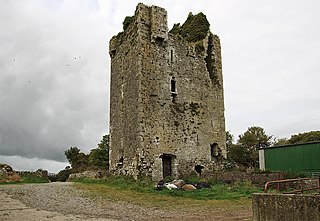
Moycarkey Castle, in Moycarky townland, County Tipperary, is a tower-house located inside a large rectangular bawn with round flanking towers at the north-eastern and south-western corners. The entrance to the tower-house is protected by a double murder-hole.
Inch is a townland of a little over 199 acres in the civil parish of the same name, in the barony of Eliogarty, County Tipperary, Ireland.
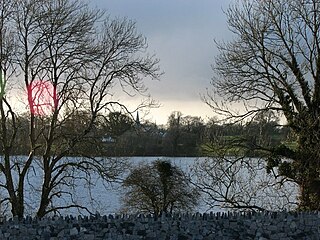
Kilnasoolagh is a civil parish in County Clare, Ireland, and a townland within that parish. Church records mention the parish in 1256.

Delvin is a barony in north-east County Westmeath, in Ireland. It was formed by 1672. It is bordered by County Meath to the east and three other baronies: Fore, Moyashel and Magheradernon and Farbill. The largest centre of population is Delvin.














